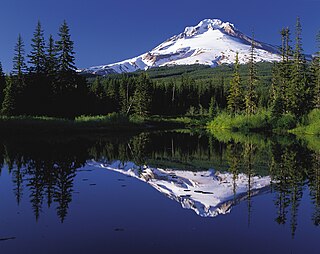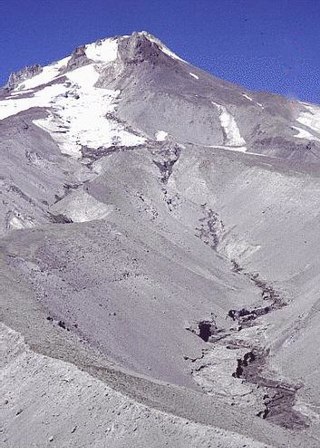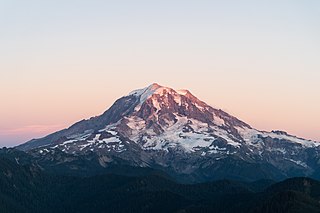
Mount Hood is an active stratovolcano in the Cascade Volcanic Arc. It was formed by a subduction zone on the Pacific coast and rests in the Pacific Northwest region of the United States. It is located about 50 mi (80 km) east-southeast of Portland, on the border between Clackamas and Hood River counties. In addition to being Oregon's highest mountain, it is one of the loftiest mountains in the nation based on its prominence, and it offers the only year-round lift-served skiing in North America.

Mount Stuart is a mountain in the Cascade Range, in the U.S. state of Washington. It is the second highest non-volcanic peak in the state, after Bonanza Peak and seventh-highest overall. Mount Stuart is the highest peak in the Stuart Range, and it is located in the central part of the Washington Cascades, south of Stevens Pass and east of Snoqualmie Pass in the Alpine Lakes Wilderness.

The Leverett Glacier is about 50 nautical miles (90 km) long and 3 to 4 nautical miles wide, flowing from the Antarctic Plateau to the south end of the Ross Ice Shelf through the Queen Maud Mountains. It is an important part of the South Pole Traverse from McMurdo Station to the Admundson–Scott South Pole Station, providing a route for tractors to climb from the ice shelf through the Transantarctic Mountains to the polar plateau.

Mount Blackburn is the highest peak in the Wrangell Mountains of Alaska in the United States. It is the fifth-highest peak in the United States and the twelfth-highest peak in North America. The mountain is an old, eroded shield volcano, the second-highest volcano in the U.S. behind Mount Bona and the fifth-highest in North America. It was named in 1885 by Lt. Henry T. Allen of the U.S. Army after Joseph Clay Stiles Blackburn, a U.S. senator from Kentucky. It is located in the heart of Wrangell – St. Elias National Park, the largest national park in the country.

Mount Moran is a mountain in Grand Teton National Park of western Wyoming, USA. The mountain is named for Thomas Moran, an American western frontier landscape artist. Mount Moran dominates the northern section of the Teton Range rising 6,000 feet (1,800 m) above Jackson Lake. Several active glaciers exist on the mountain with Skillet Glacier plainly visible on the monolithic east face. Like the Middle Teton in the same range, Mount Moran's face is marked by a distinctive basalt intrusion known as the Black Dike.

Mount Bona is one of the major mountains of the Saint Elias Mountains in eastern Alaska, and is the fifth-highest independent peak in the United States. It is either the tenth- or eleventh-highest peak in North America. Mount Bona and its adjacent neighbor Mount Churchill are both large ice-covered stratovolcanoes. Bona has the distinction of being the highest volcano in the United States and the fourth-highest in North America, outranked only by the three highest Mexican volcanoes, Pico de Orizaba, Popocatépetl, and Iztaccíhuatl. Its summit is a small stratovolcano on top of a high platform of sedimentary rocks.

Mount Wilson is the highest summit of the San Miguel Mountains range of the Rocky Mountains of North America. The prominent 14,252-foot (4,344 m) fourteener is located in the Lizard Head Wilderness of San Juan National Forest, 10.6 miles (17.1 km) north by east of the Town of Rico in Dolores County, Colorado, United States. Mount Wilson should not be confused with the lower Wilson Peak nearby.

Skillet Glacier is in Grand Teton National Park, Wyoming, United States. The glacier is situated on the eastern cliffs of Mount Moran and is easily seen from Jackson Hole. The shape of the glacier led to the naming as the uppermost section of the glacier is long and narrow and then broadens abruptly more than halfway down the mountain into a larger area, giving it the shape of a skillet or frying pan. The glacier is one of twelve that remain in Grand Teton National Park and one of five glaciers located on Mount Moran. Mountain climbers consider the Skillet Glacier route to be the fastest and one of the easiest ways to climb Mount Moran, and was the route taken when the peak was first climbed in 1922, though it is rarely used in late summer due to poor footing. On November 21, 1950, A DC-3 crashed into Mount Moran, adjacent to Skillet Glacier, killing all 21 passengers aboard. The remains of the passengers and the plane are still on the mountain.

Falling Ice Glacier is located in the Grand Teton National Park, Wyoming, United States. The glacier is situated on the southeastern cliffs of Mount Moran and can be seen from Jackson Hole. Runoff from the glacier flows into Leigh Lake. The glacier is located in a high altitude cirque and is along one of the major climbing routes to the summit of Mount Moran. All of the existing glaciers in Grand Teton National Park were created during the Little Ice Age (1350–1850 A.D.) and have been in a general state of retreat since the mid-19th century.

The Black Buttes, also known historically as the Sawtooth Rocks, make up an extinct stratovolcano in the Cascade Volcanic Arc in Whatcom County, Washington, United States. Glacially eroded remnants of this volcano rise above the Deming Glacier, part of the glacier system of the nearby volcano, Mount Baker. There are three major peaks — Colfax, Lincoln, and Seward — all of which can be climbed.

Adams Glacier is situated on the northwest flank of Mount Adams, a 12,281-foot (3,743 m) stratovolcano in the U.S. state of Washington. Much of it becomes the source of Adams Creek, a tributary of the Cispus River. It is the largest glacier on Mount Adams. It flows down from the summit ice cap at over 12,000 feet (3,700 m) for over 2.5 miles (4.0 km) to a terminus near 7,000 feet (2,100 m).

The Coalman Glacier is a glacier located on the upper slopes of Mount Hood in the U.S. state of Oregon. It is the mountain's highest glacier ranging from about 11,200 to 10,500 ft, located within the crater rim, southwest of the peak. It was named for Elija Coalman, an early mountain guide who climbed Mount Hood 586 times.

Mount Sacagawea is the eighth-highest peak in the U.S. state of Wyoming and the seventh-highest in the Wind River Range. It was named after Sacagawea, the young Lemhi Shoshone woman who accompanied the Lewis and Clark Expedition as an interpreter and guide. The Upper Fremont Glacier is located southeast and the Sacagawea Glacier is northeast of the mountain. Straddling the Continental Divide, Mount Sacagawea is one mile (1.6 km) northwest of Fremont Peak.

Mount Woodrow Wilson is located in the Wind River Range in the U.S. state of Wyoming. Mount Woodrow Wilson is the eighth-highest mountain in the range and the ninth-highest in Wyoming. The summit is located in the Bridger Wilderness of Bridger-Teton National Forest on the Continental Divide, 1.25 miles (2.01 km) south of Gannett Peak. The flanks of the mountain are covered in snowfields and glaciers, including Dinwoody Glacier to the northeast, Mammoth Glacier to the west and Sphinx Glacier to the south.

White River Glacier is an alpine glacier located on the south slopes of Mount Hood in the U.S. state of Oregon. It ranges in elevation from about 10,000 to 6,200 feet. It is among the best known of the twelve glaciers on the mountain, and the lower reaches are a popular destination for Nordic skiing enthusiasts. The glacier is the source of the White River, a tributary of the Deschutes River, and has a long history of washing out the bridge where Oregon Route 35 crosses at 45.30307°N 121.67208°W.

Mount Rainier, also known as Tahoma, is a large active stratovolcano in the Cascade Range of the Pacific Northwest in the United States. The mountain is located in Mount Rainier National Park about 59 miles (95 km) south-southeast of Seattle. With a summit elevation of 14,411 ft (4,392 m), it is the highest mountain in the U.S. state of Washington, the most topographically prominent mountain in the contiguous United States, and the tallest in the Cascade Volcanic Arc.

Price Glacier is in North Cascades National Park in the U.S. state of Washington, on the northeast slopes of Mount Shuksan, below the subpeak known as Nooksack Tower. Price Glacier descends from 8,600 to 4,200 ft and is the steepest and most heavily crevasseed glacier on Mount Shuksan. The disconnected lowest portions of Price Glacier calve small icebergs into Price Lake.
Entiat Glacier is in Wenatchee National Forest in the U.S. state of Washington, on the northeast slopes of Mount Maude. Disconnected at several spots, the Entiat Glacier is in a cirque above the Entiat Valley and is the source of the Entiat River. The southern section of the glacier is the largest.
Katsuk Glacier is in North Cascades National Park in the U.S. state of Washington, in a cirque to the north of Katsuk Peak and east of Kimtah Peak. Both Katsuk and Kimtah Peaks are prominent summits along a ridge known as Jagged Edge. Katsuk Glacier consists of three disconnected sections, the largest of which stretches for over 1 mi (1.6 km) in width. Kimtah Glacier is immediately west of Katsuk Glacier, while the Mesahchie Glacier lies to the east.
Mesahchie Glacier is in North Cascades National Park in the U.S. state of Washington, in a cirque to the northeast of Mesahchie Peak. Mesahchie Peak is the highest summit along a ridge known as Jagged Edge. Mesahchie Glacier is approximately .75 mi (1.21 km) in width and is immediately east of Katsuk Glacier.
















